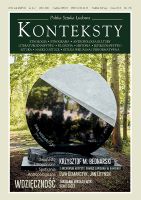Dom wieczności, dom wdzięczności
House of Eternity, House of Gratitude
Author(s): Monika SznajdermanSubject(s): Social history, WW II and following years (1940 - 1949), History of the Holocaust
Published by: Instytut Sztuki Polskiej Akademii Nauk
Keywords: Gorlice; Jews; memory; Holocaust;
Summary/Abstract: This text is dedicated to the Jewish cemetery in Gorlice – a sub-Carpathian town up to the Second World War inhabited by more than 3 000 Jews, male and female, i.e. slightly over 50 percent of the entire population. The cemetery contains only an ohel and several matzevahs, but it is difficult to decipher anything featured on them. Memory too is defunct in spite of the fact that thousands were buried here – the cemetery is already over 200 years old. Nonetheless, life goes on and that which once was human is now intertwined and becomes a unity with plants and, more extensively, with Nature. The cemetery is overgrown by old trees and shrubs; stones crumble and establish symbiosis with plants covering them; deer graze in high grass. Ewa Domańska wrote in Nekros: a cemetery is “a terrain of widely comprehended heritage, transgressing the ideas of culture and Nature, a chronological line of short time; a place where time unravels and assorted entangled histories, to use a term devised by quantum physicists, function, and where various chemical and physical processes turn into processes creating the sphere of the sacrum”. The author of the article is interested precisely in those “entangled histories” and crumbling space, which initiate a joint – botanicalanthropological – story about the Jews of Gorlice, their life and death, the traces they left behind, and the new form of existence whose part they are. “Woven into / eternal being – / you shall not elapse, / not elapse” – the poetess wrote?
Journal: Konteksty
- Issue Year: 340/2023
- Issue No: 1-2
- Page Range: 105-116
- Page Count: 14
- Language: Polish

